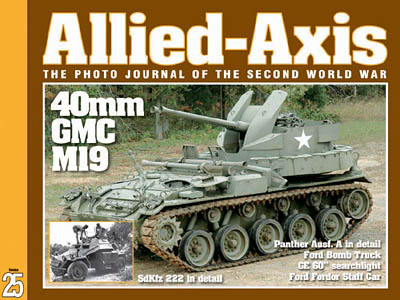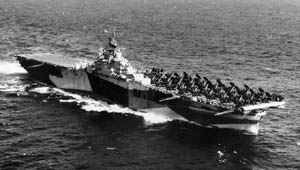U.S. soldiers demonstrate captured German remote-controlled Goliath demolition tanks (Leichter Ladungsträger Goliath, SdKfz. 302/303).
U.S. soldiers demonstrate captured German remote-controlled Goliath demolition tanks (Leichter Ladungsträger Goliath, SdKfz. 302/303).
From The Ordnance Soldier’s Guide, 3rd Edition, Ordnance Replacement Training Center, Aberdeen Proving Ground:
RESPONSIBILITY FOR PROPERTY: Clothing and equipment issued to you are government property. If any articles are lost or damaged through your fault or negligence you will be required to pay for them. If you were responsible for the loss or damage, through fault or negligence, then you should admit that fact by signing a “Statement of Charges.” If, however, you believe that you were not responsible, do not sign this statement. In the latter case a “Report of Survey” will be made out and a Surveying Officer will determine whether or not you are to be held responsible. When articles of clothing or equipment have become worn out through ordinary wear and tear, no one is held responsible for the value and the worn articles may be exchanged for new ones.
CARE AND CLEANING OF SHOULDER WEAPONS: Rifle and Carbine—Clean metal parts with sperm oil. Clean bore with rifle bore cleaner or G.I. soap and hot water. Treat stock and hand guards with linseed oil. Treat sling with neatsfoot oil.
CARE OF TENTING EQUIPMENT: Pegs: Do not hammer pegs into hard ground. Canvas: Brush and dry thoroughly before folding and storing. Rope: Wash thoroughly and dry before storing.
The latest issue of Ampersand Publishing’s reference magazine Allied-Axis: The Photo Journal of the Second World War has been announced. This issue of Allied-Axis will cover the 40mm Gun Motor Carriage M19, Panther Ausf. A, General Electric 60″ Searchlight, SdKfz 222 Armored Car, Ford Bomb Truck, and Ford Fordor Staff Car.

B-29 Superfortress “Gravel Gertie” after landing gear collapse on Saipan, Marianas Islands. “Gravel Gertie” served with the 882nd Bombardment Squadron, 500th Bombardment Group, Twentieth Air Force. (U.S. Air Force Photograph.)
U.S. troops demonstrate a captured Granatwerfer 42 (12cm GrW 42) German heavy mortar on the First Army Front in Echtz, near Duren, Germany.
Emergency exit routes of the TBM Avenger for both ditching and bailout in flight. The turret exit could not be used by the gunner to bail out during flight, because the gunner did not wear his parachute in flight. The gunner’s parachute was stored above the door in the bombardier’s compartment.
Source: Pilot’s Handbook of Flight Operating Instructions, Navy Model TBM-3 Airplane, November 1945.
From Combat Lessons No. 6:
De-Mechanized Warfare
In a gesture of protest against the trend toward complete mechanization, the wire team shown at work in the accompanying photo picked up an idle buggy in a front-line town, conscripted a “liberated” horse, and set off to salvage much-needed wire. The horse is garbed becomingly in an air-ground recognition panel. Despite an enthusiastic report on the project, no change in T/O and E is contemplated by the War Department.

Aircraft Carrier USS Bennington (CV-20) in Oct. 1944
Divers in New York have found over 1,500 live naval ammunition shells in the waters under the Verrazano Bridge in New York. The WWII-era copper shells are believed to have fallen overboard during an accident offloading ammunition from the aircraft carrier USS Bennington over 65 years ago. Some of the shells now lay only 20 feet below the water. If the ammunition is still live, the shells could be dangerous if disturbed by passing ships or construction activities.
More information on the USS Bennington from Wikipedia:
USS Bennington (CV-20) was one of 24 Essex-class aircraft carriers built during World War II for the United States Navy. The ship was the second US Navy ship to bear the name, and was named for the Revolutionary War Battle of Bennington (Vermont). Bennington was commissioned in August 1944, and served in several of the later campaigns in the Pacific Theater of Operations, earning three battle stars. Decommissioned shortly after the end of the war, she was modernized and recommissioned in the early 1950s as an attack carrier (CVA), and then eventually became an Antisubmarine Aircraft Carrier (CVS). In her second career, she spent most of her time in the Pacific, earning five battle stars for action during the Vietnam War. She served as the recovery ship for the Apollo 4 space mission. She was decommissioned in 1970, and sold for scrap in 1994.
U.S. Air Force photograph of Lt. James O. Fincher of the 392nd Fighter Squadron, 367th Fighter Group in his P-38J Lightning “Arkansas Traveler” along with his ground crew. The P-38 was photographed at Clastres Airfield, France in October 1944.